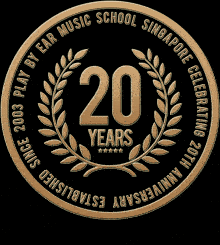'Piano chords?'
You hear about them all the time, piano chords. First and foremost, there isn’t really a “piano chord” or a ‘chord piano’. A chord is universal and the same chord can be played on most musical instruments, like a guitar, an organ, harp, etc. Nevertheless, this lesson is essentially a quick comprehensive chord guide for pianist. But what are chords? A chord is created when three or more notes are stacked on top of one another. Well, even if you play the notes separately one at a time, you form a chord too. Basically, a chord forms the harmony, and most (and almost all) contemporary styles (in pop&jazz) are organized harmonically around chords. When we improvise on the piano, we improvise using the chords given in the song.
How to form a CHORD using numeric formulas?
In this lesson, we will show you how to form the basic major and minor chords using the numeral formula. The formula for a major chord is 1-3-5 and the formula for a minor chord is 1-b3-5.
(We assume that you know what is b (flat) and # (sharp) in music)
Next, let’s look at a C major scale (which we will be using as a guide for the rest of the other chapters in this lesson): C(1) – D(2) – E(3) – F(4) – G(5) – A(6) – B(7) – C
When we apply the formula, you will get this:
C major chord = C (1) – E (3) – G (5) / C minor chord = C (1) – Eb (b3) – G (5)
Which means, C major chord = C-E-G, and a C minor chord = C-Eb-G.
If you are able to understand this logic, let’s move on. As you know, this is an express lesson, and we suggest you should not be bothered too much about the theory behind everything for now, there’s too much to absorb. It’s more important that you are able to form the chords quickly and be able to play them first.
Major and Minor chords
Shown below are the piano diagrams for all 12 major and minor chords. It is important to know the rest of the other more complex chords actually derive from either a major or minor chord. If you like to practise on these chords, you should start with the 6 basic chords – C major, F major, G major, D minor, E minor and A minor. These are the easiest as they consist only white keys. And when you play a song in a key of C, these are the 6 basic chords you will use more often than any other chords.
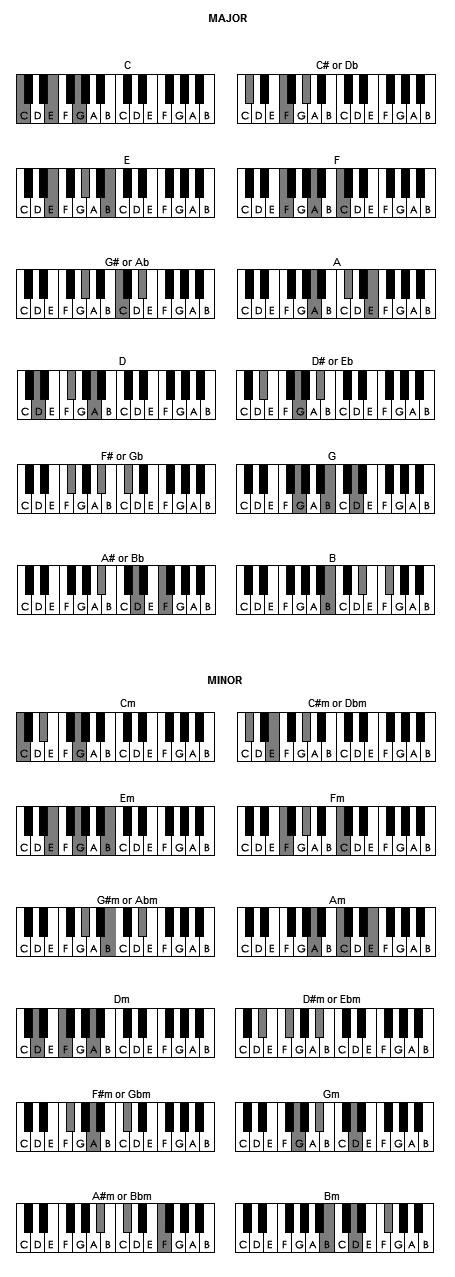
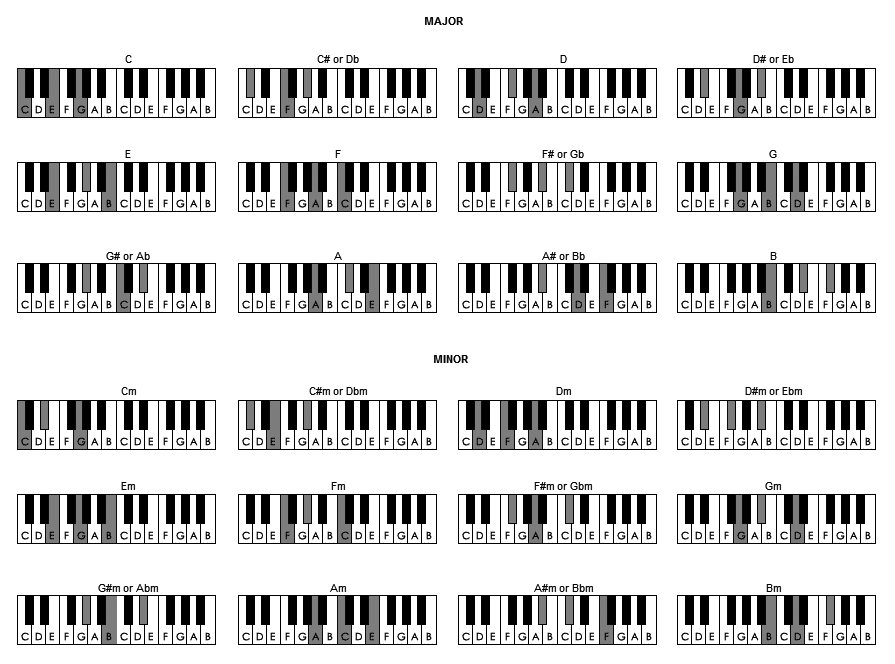
Augmented and Diminished
The formula for Augmented = 1-3-#5 | The formula for Diminished = 1-b3-b5
The augmented chord has a distinctive ‘hanging in the air’ sound, while the diminished chord has that horror flick sound. It is important to know that both the augmented and the diminished chords are part of the 4 basic triad family (including major & minor). A triad is a basic chord consisting of only 3 notes. Below are the 12 augmented and 12 diminished chords. The rest of the other chords that you will be learning below are either alterations or additions to the 4 basic triads.
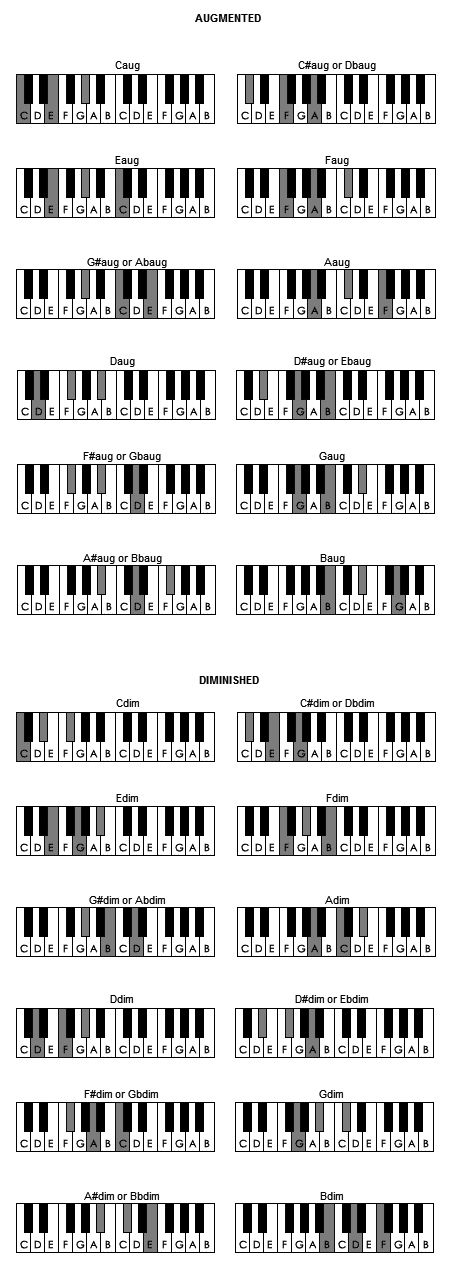
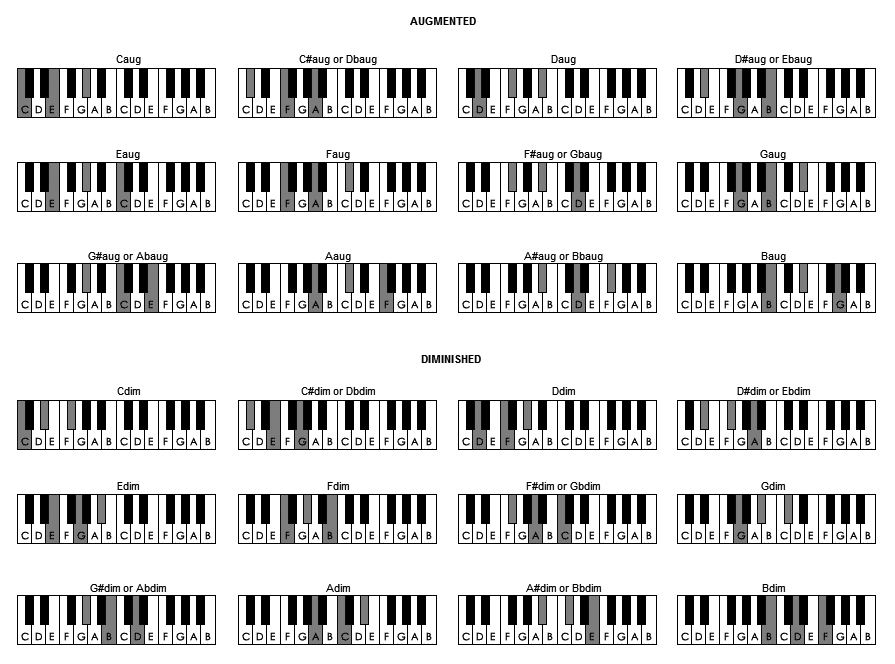
The 4 and the 5
The formula for Suspended = 1-4-5 | The formula for Flat fifth = 1-3-b5
As the chord name suspended suggests, the suspended chord gives a suspense feel that needs to be resolved immediately. It is a major chord, with the 3rd note raised to the 4th note. The suspended chord is also commonly known as sus4, and that 4th note is the note responsible for that suspense. In most popular styles, the suspend chord usually resolves back to the original major chord. (Moving from the 4th note to the 3rd note)The flat fifth chord is an altered chord. It is primarily a major chord with a 5th note flatted.
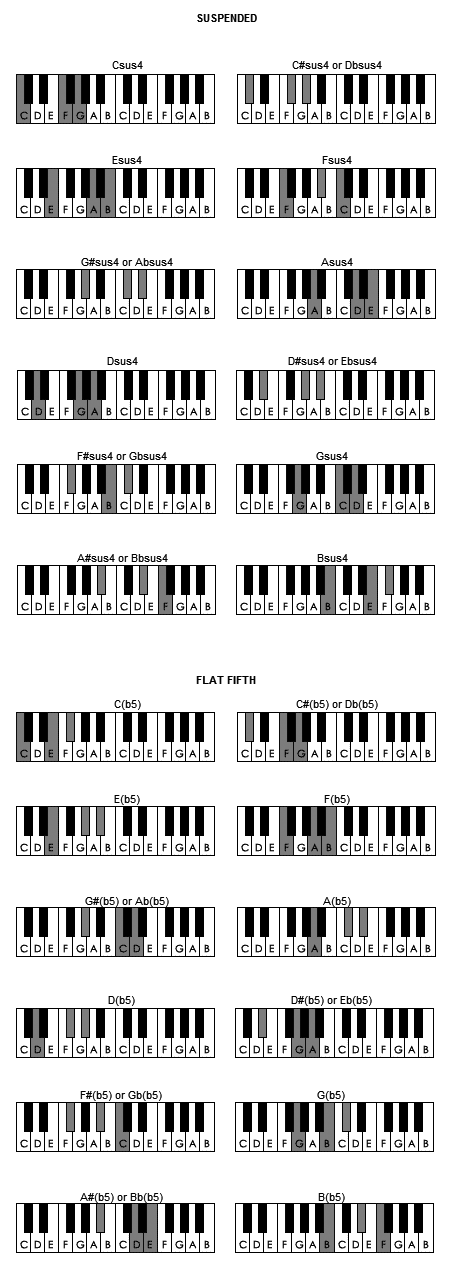
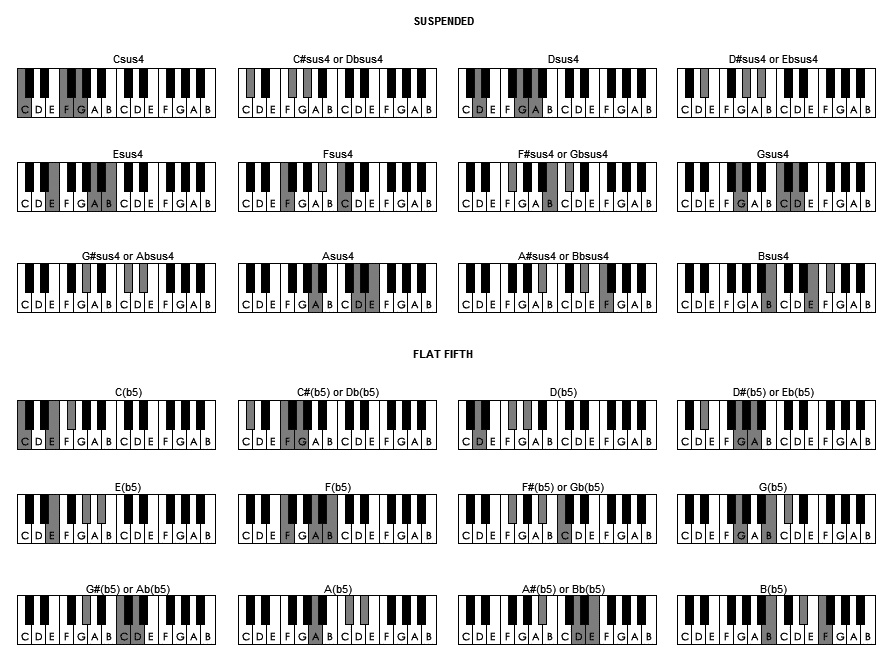
The Sixth
The formula for Sixth = 1-3-5-6 | The formula for Minor Sixth = 1-b3-5-6
So far, we have covered the 1 to 5, now its time for the 6th! The sixth chords are nothing more than major or minor chords with an added 6th note. In the modern era, it is called the added sixth chord. In jazz pieces, the sixth chord (especially the minor sixth) is commonly used, together with 6/9 chords. *We will learn about 9th chords later on. For now, take a look at the sixth and minor sixth chords.
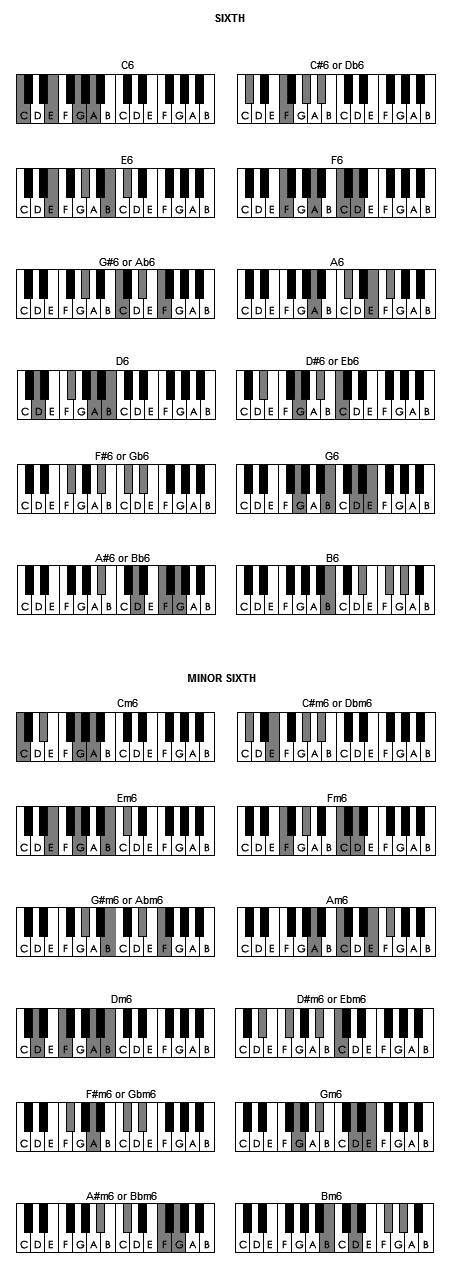
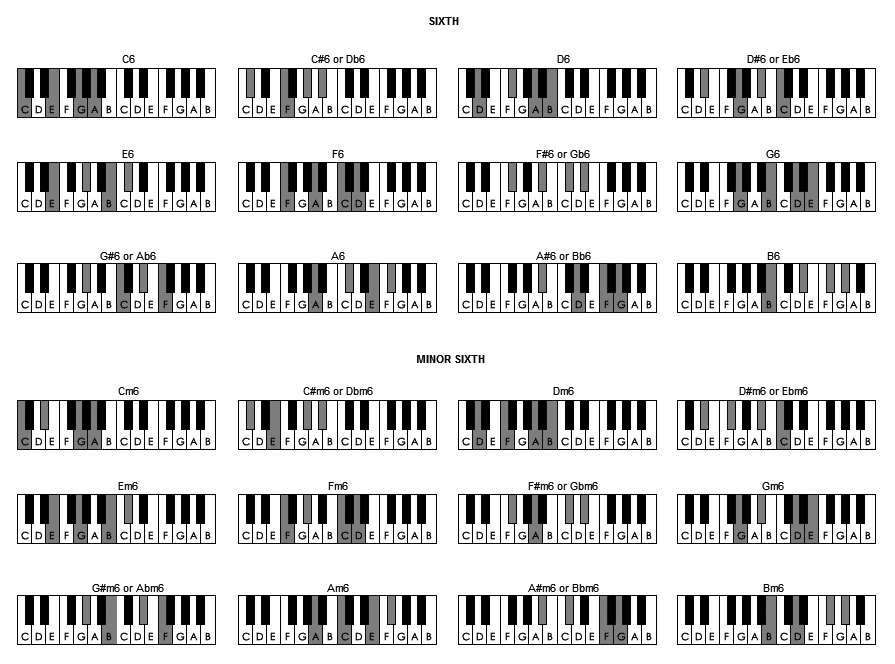
The Seventh
The formula for Seventh = 1-3-5-b7 | The formula for Minor Seventh = 1-b3-5-b7
The family of 7th chords can get a little confusing. In summary, there are four basic types of 7th chords – Dominant seventh, major seventh, minor seventh, diminished seventh. The seventh chord is the dominant seventh chord which refers to a major chord with an additional flat 7th note and it is known as just the seventh chord with only a symbol 7. A minor 7th note (in a minor seventh chord) is technically the same as a dominant 7th note in a major chord. The seventh chords are widely used in Jazz and especially in Blues style.
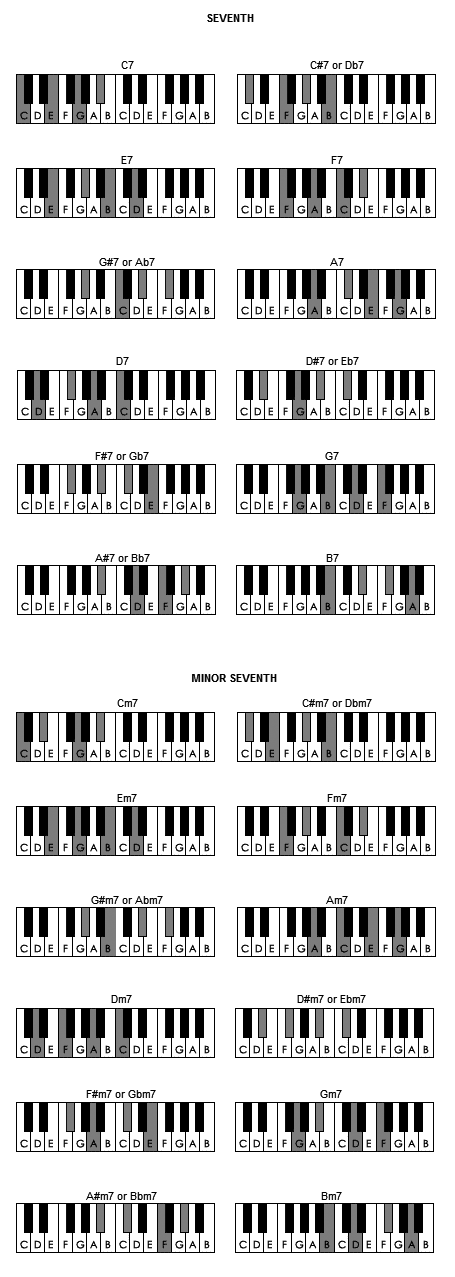
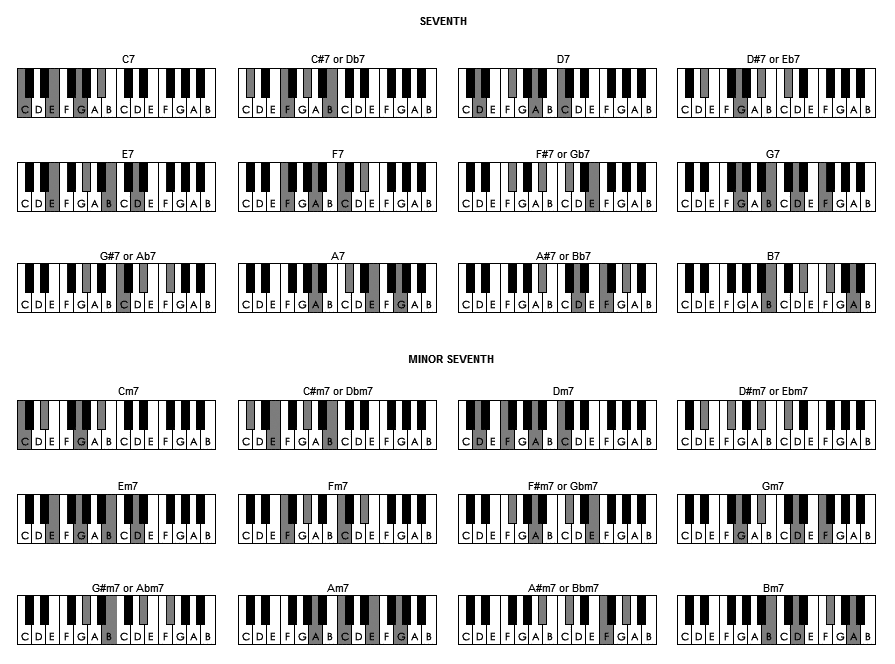
The Major Seventh and Diminished seventh
The formula for Major Seventh = 1-3-5-7 | The formula for Diminished Seventh = 1-b3-b5-bb7
Ok, this is when the confusion starts. Previously we learnt about the seventh chord, which technically is also a major chord. But a major seventh chord (written as maj7) is different. Maj 7 chord is an additional natural 7th note rather than flat (b) 7th note. To put it in simply terms, C7 = C,E,G,Bb whereas Cmaj7 = C,E,G,B Diminished seventh is an additional double flat 7th note, or simply a 6th note to a diminished chord.
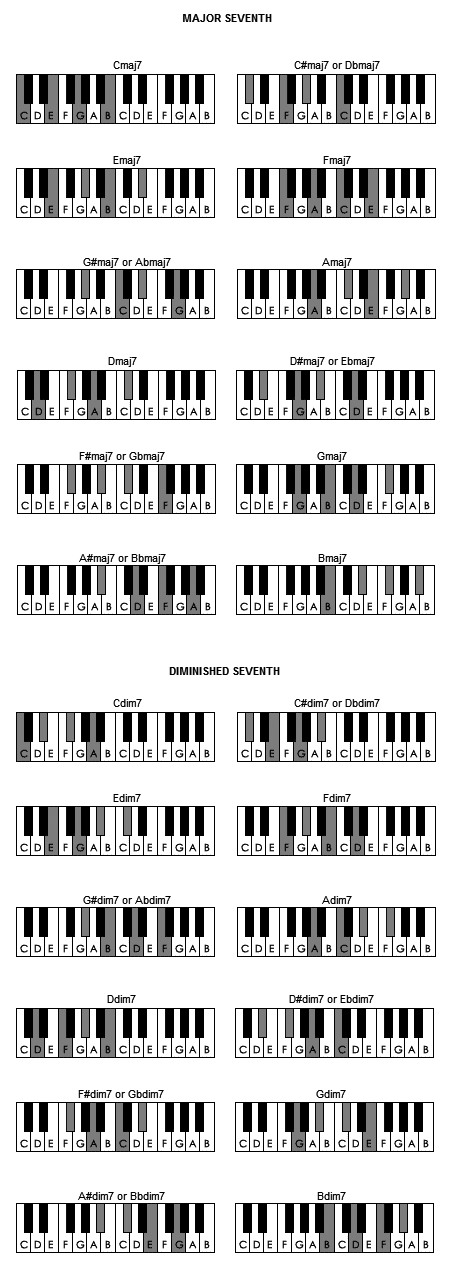
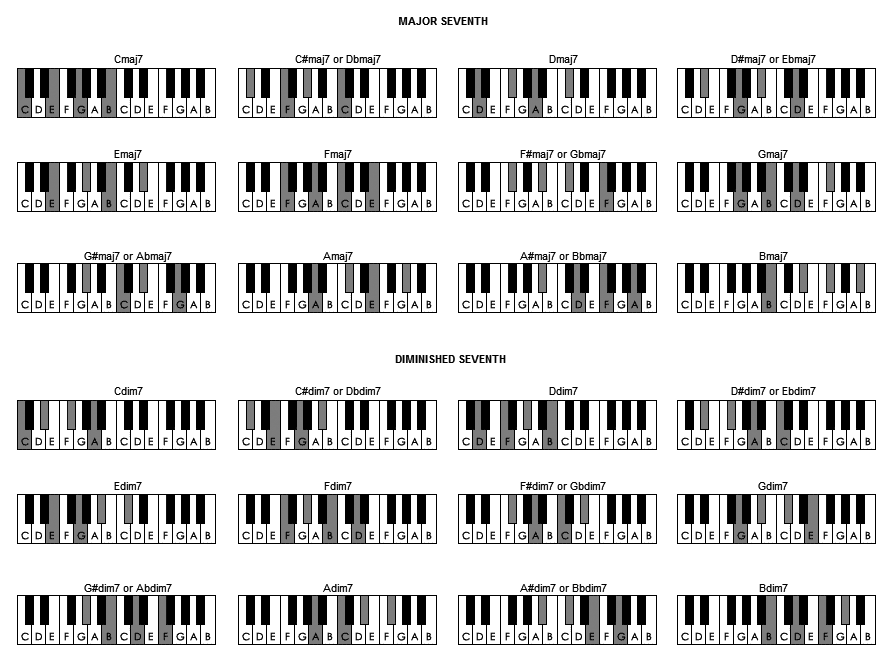
The Seventh flat fifth and Minor seventh flat fifth
The formula for Seventh flat fifth = 1-3-b5-b7 | The
formula for Minor Seventh flat fifth (half-diminished seventh) =
1-b3-b5-b7
If you have come so far in this lesson, and you
understand the difference between the seventh, the minor seventh, and
major seventh, the rest of the chords from now will be quite self
explanatory! The seventh flat fifth and minor seventh flat fifth are
altered chords, with a flat seven and a flat fifth on a major and a
minor triad respectively. The minor seventh flat fifth is also commonly
known as half diminished seventh, which is commonly used in many Jazz
chord progressions.
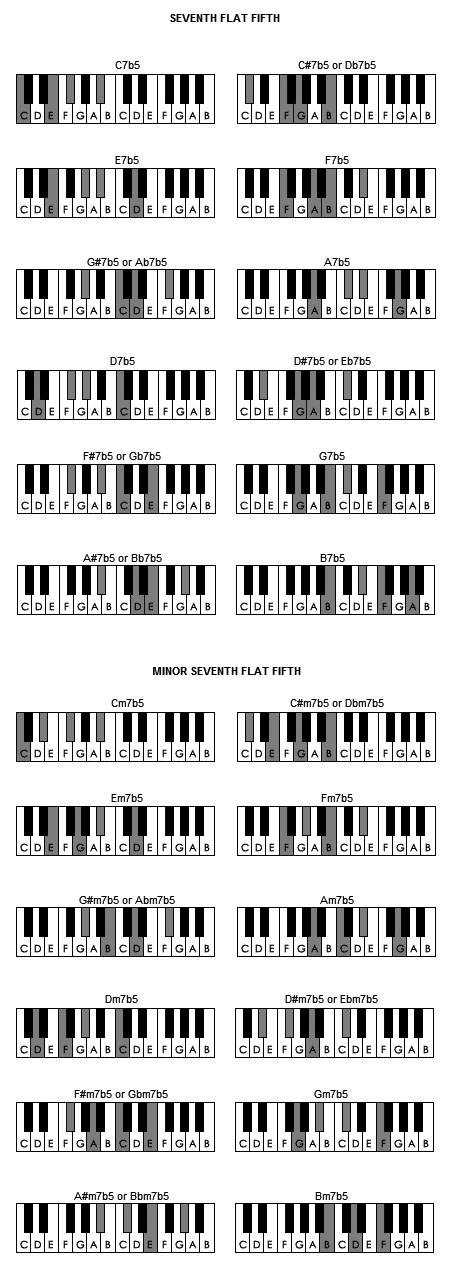
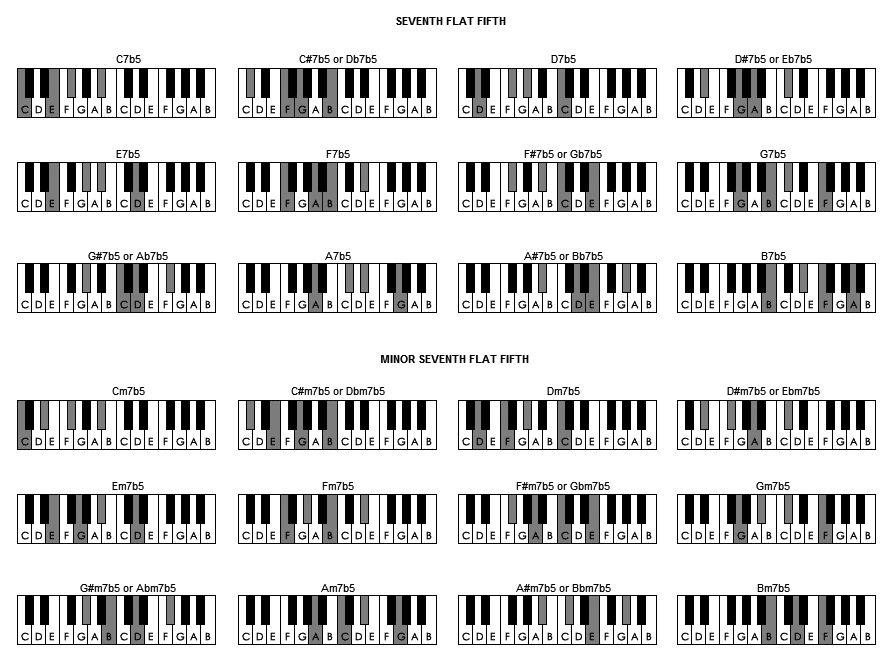
The Seventh flat ninth and seventh sharp ninth
The formula for Seventh flat ninth = 1-3-5-b7-b9 | The formula for Seventh sharp ninth = 1-3-5-b7-#9
What’s next? The sharp 9 and the flat 9. The sharp/flat 9 can be altered onto a dominant chord (seventh chord) or minor seventh chord. However, it is quite rare to have a sharp/flat 9 note in a major seventh chord (maj7). The 7b9 chord is actually very similar to a diminished chord over the chord root note. Take a look at C7b9 for instance. When you break it up, you can see that it is essentially C#dim7 chord with a C root note. If you do the same for C7#9 chord, you get Cm over a C7 chord. It gives a interesting ‘clashing’ sound.
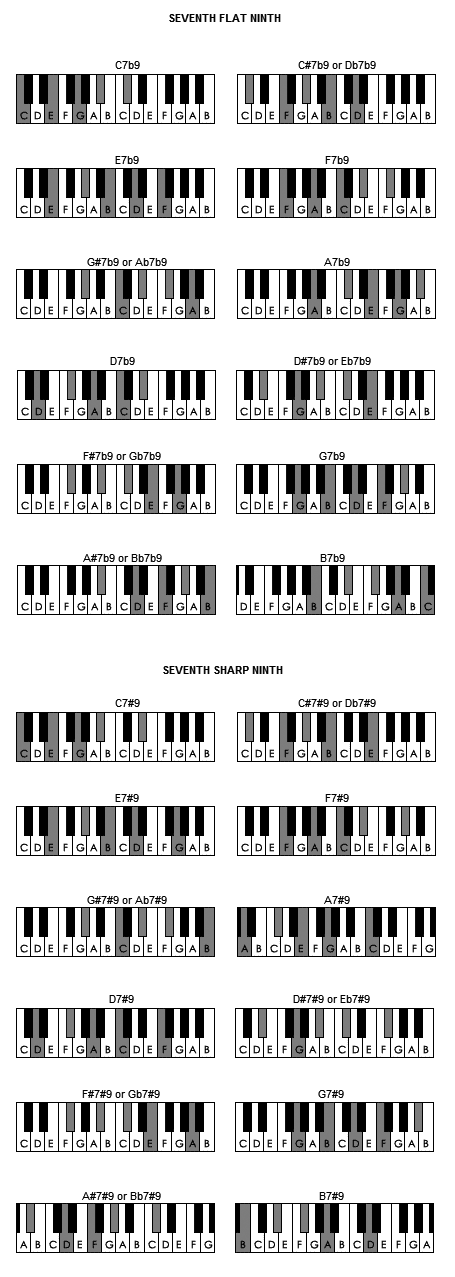
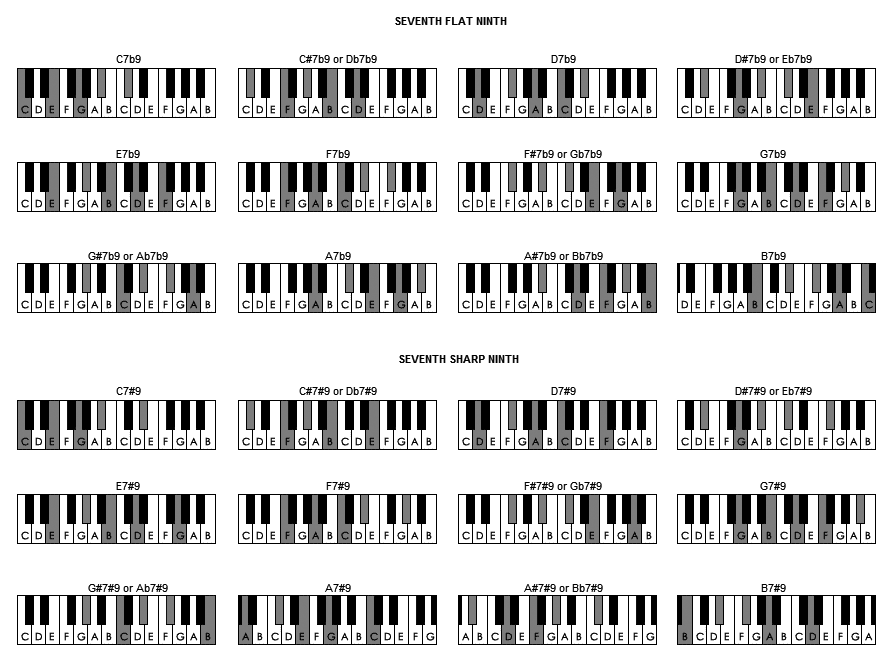
The Eleventh and Thirteenth
Not to worry, music stops at the thirteenth note. Let’s put it in an easier way to understand, the 9th, 11th and 13th is mathematically the same as the 2nd, 4th and 6th. So if you have a chord C add9, it’s ‘quite’ the same as adding a 2nd note to C chord. In summary, the higher number you go (etc. 13th), the nire notes you need to include in a chord. For example: C13 chord will have to include all 1st ,3rd ,5th ,7th ,9th ,11th ,13th notes. Whereas, C11 chord includes everything up to the 11th note only. Because there are just too many chord combinations, this will be our last page of chords.

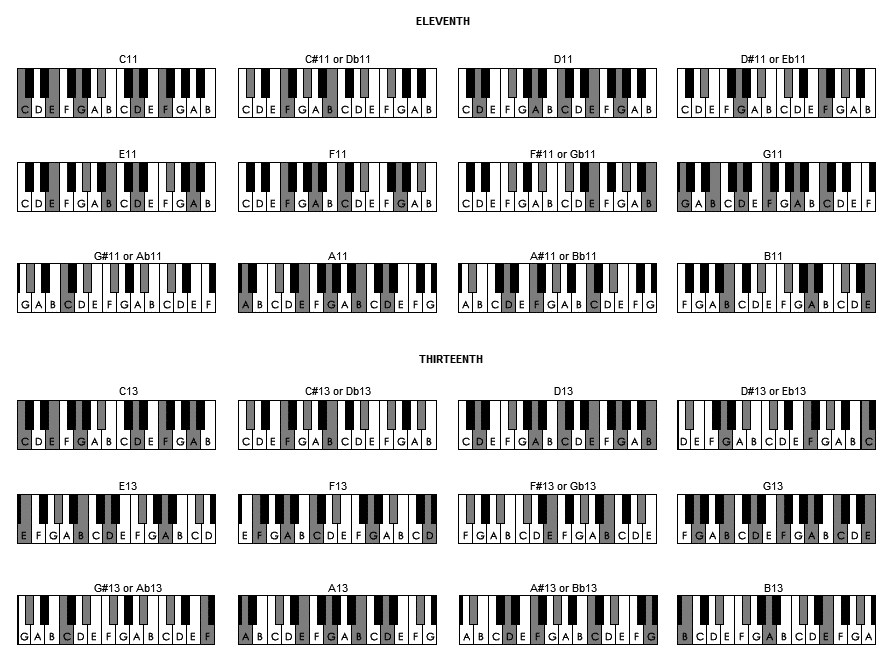
Few important points:
1) Try yourself to form the other combinations of chords, like #5(b9), maj11, maj13(#11), and so on. If you follow the formulas accordingly, you should be able to form any combination of chords!
2) There is no one specific way to play a chord. All the chord piano diagrams in this lesson are in root position. There are at least 2 inversions for every chord. And for chords with more than 4 notes, there are several different chord voicings to play with. Every Jazz musician has their preferred chord voicings.
3) If you have to start somewhere, it will be very ideal to memorise the chord formula before you start memorising every chord 1 by 1. Because there are more than a few hundred different chords, you won’t be able to remember all of them until you are very experienced.
4) There are many different formulas to form the same chord. For instance, some formula involves with scales or half steps or other numbers, etc. Stick to one formula you prefer that is easy for you to understand.
5) Although there may be hundreds of different chords, there are only 12 different notes. And that means, mathematically, many of the chords are similar to one and other. Sometimes when chords get a little huge for example a Cmaj13, you should break it up into 2 separate chords, and learn it that way. Another example, although there are 12 dim7th chords, every four dim7th chords are completely identical to each other. That makes life so much easier, because you only need to memorize one dim7th chord to know all four dim7th chords.
6) The best way to learn chords is to apply them in a song, rather than to play all of them in series of practise (1by1). For instance, grab a new song. Perhaps out of the 10 chords in that new song, you already know 8 of them. When you attempt to play the 2 chords are unsure of, you will be better in remembering them, because you actually apply the chords to a song that you can already play 80% of it (8/10)
We hope you have benefited from our PBE FREE online lessons.
